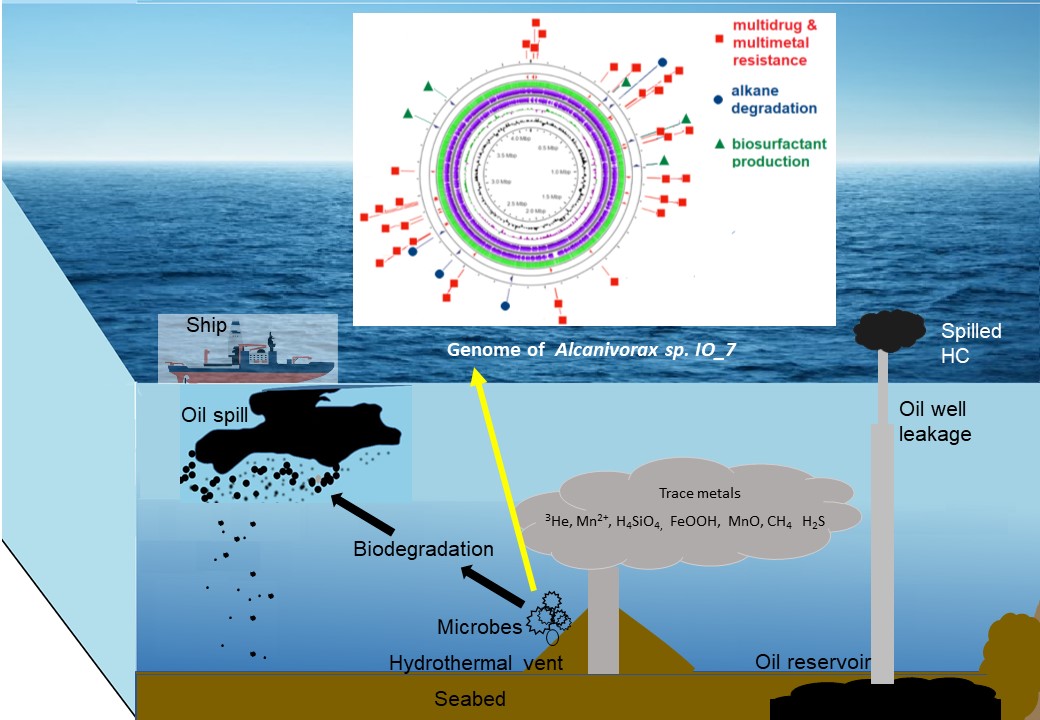- Screen Reader Access
- Skip to : main content / navigation
- Text Size
- Home
- Sitemap
- Contact us
- हिंदी
NCPOR’s publication impact factor has increased by 128% in 2020-21 from last year. To enhance the reach of the published research to a larger audience, we introduce- NCPOR's 'Science Update', a platform where NCPOR publications will be shared in a mass language.
As a first part of the series, we introduce 3 stories that dive from the past to the present and to the future.
Effect of Winds and Gyres on Sea-Ice

Schematic of the major physical and biological processes, along with the measurement platforms in the polar regions, under the present scenario of increased warming and sea-ice decline
A layer of ice over sea surface limits incoming solar radiation and photosynthesis in the polar oceans. The sea-ice is made up of fresh water which is less dense than the saline deeper waters. This kind of difference in salinity stratifies the polar oceans. Declining sea-ice results in open water which absorbs more heat and enhances primary production.
In the Greenland Sea, sea-ice variation is mainly controlled by local formation, melting, exports across the Fram strait, and sea-ice dynamics. But this is not the complete picture. Researchers from the NCPOR along with collaborators from Norway have identified one more player- combined role of large scale atmospheric and oceanic circulations in the Nordic seas, comprising the Greenland Sea, Iceland Sea and Norwegian Sea. To show this, they used a suite of satellite and ocean-atmospheric reanalysis data.
The team led by Sourav Chatterjee from NCPOR showed that lower than normal sea level pressure over the nordic seas results in stronger winds from the north that blow parallel to the east coast of Greenland. Due to the Earth’s rotational effect, these winds drift the sea-ice towards the eastern coast reducing freshwater content in the Greenland Sea. Parallely, the winds strengthen the Greenland Sea gyre circulation. This strengthening can recirculate the subsurface warm-saline Atlantic waters from the Fram strait to the south-western Greenland Sea. Overall, the sea-ice drift and Atlantic water inflow weakens the stratification and increases vertical mixing, thus warming the upper ocean. This enhances melting from the bottom and inhibits fresh sea-ice formation.
Thus, commonly occurring winds from the north, when gaining speed, strengthen the Greenland Sea gyre and together they lead to sea-ice reduction in the central Greenland Sea. To read more https://doi.org/10.5194/tc-15-1307-2021
This is not the first time sea-ice is declining on the Earth. The glacial-interglacial cycles have been an intricate part in the past. To understand this more, a paleoclimate team from the NCPOR led by Rahul Mohan used sediment cores from the Southern Ocean. Sediment cores carry imprints from different times in the past preserved at different depths. From the core, they examined fossilized diatoms - one of the primary producers in the ocean. The team derived the sea surface temperature, sea-ice concentration and productivity from the diatoms. They compared these with the other data reported at nearby locations in the Southern Ocean and revealed a story of 156 thousand years before today, covering the last glacial-interglacial periods.
The researchers found that during the glacial periods, the sea-ice coverage extended northward by a few degrees of latitude as compared to the interglacial periods. This co-occurred with a shift in productivity away from the Antarctica coast. They explained that this higher sea-ice extent was driven by stronger winds and ocean currents, which also fueled the Weddell Sea gyre located in the Southern Ocean below the Atlantic Ocean. The strengthened gyre pushed cold waters northward thereby extending the sea-ice coverage further to the north. The sea-ice covered area limited the productivity. The northward movement of the gyre pushes nutrients too, driving the productive grounds away from the coast.
Thus, both the past and present show that apart from temperature, winds and gyres can also affect the sea-ice. To read more https://doi.org/10.1016/j.marmicro.2020.101894
A Multitasker from Hydrothermal Vents

Schematic showing hydrocarbon sources in the ocean and hydrocarbon-degrading microbes along with the genome of Alcanivorax sp. IO_7
While the sea-ice decline leads to more heat supply through the upper ocean, the hydrothermal vents are heat sources at the sea bottom near ridges where two tectonic plates meet. As sunlight and nutrients are limited at the bottom, organisms thrive by using minerals and other chemicals that seep out from the vents. Recently, a NCPOR research team led by K. P. Krishnan explored the south-west Indian Ocean ridge region and collected a bacteria belonging to Alcanivorax, a hydrocarbon degrading genus. Several species of this genus have been earlier employed for containing oil spills in seawater. But, what makes the bacteria so efficient in handling such spills? To find out, the team mined the whole genome of the bacteria and located genomic islands responsible for hydrocarbon degradation. The bacteria acquire these islands from organisms other than their parents via gene transfer to adapt and evolve under specific environmental conditions. But, how do the bacteria solubilize these long chain hydrophobic hydrocarbons? The team found genetic regions in the bacteria that produce biosurfactants to solubilize hydrocarbons for easy uptake. The researchers also located multimetal and multidrug resistant genomic islands which again helps them to survive in metal and chemical-rich environments of hydrothermal vents. Thus, along with hydrocarbon degrading enzymes, the genus from the hydrothermal vent region curates genetic information for the production of biosurfactants and other natural products. To read more https://doi.org/10.1016/j.ygeno.2020.10.020
Science Updates Team: Archana Singh, Divya David T, and Swati Nagar